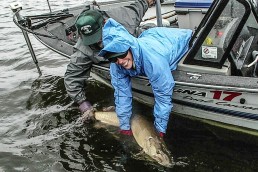No Tigers in Missouri
SHARE THIS POST
A bloodcurdling scream from the back of the boat penetrated the Northwoods’ early morning serenity, echoing off the shoreline and water. Our teenage daughter followed the scream with this wide-eyed proclamation, “An alligator followed my lure to the boat.”
“There are no alligators this far north,” I responded.
“But it had a big head with eyes on top, a big mouth and big teeth,” she argued.
“Did it have four legs?” I asked. “Must have been a muskie,” she responded.
Acknowledged as the top predator in their waters, muskies eat nearly any creature that fits into their mouth. In spite of that, they are known as ‘the fish of 10,000 casts’ because some anglers fish for days or weeks without seeing or catching a muskie. So, what is the mystique? Why do anglers cast huge wooden lures until their arms ache?
“It’s the fish’s size; a trophy muskie is 45 to 50-inches long. Plus, there is the surprise factor; sometimes a muskie follows a lure to the boat, nipping at the tail—like a taste test. Other times, the strike is a violent explosion of fish, lure and water,” said Jim Saric, former Owner/editor/publisher of Musky Hunter Magazine. “Once hooked, their fight is magnificent, leaping like a swordfish and pulling like a freight train.”
Muskies moved in
No wonder anglers travel hundreds of miles and spend a lifetime in search of this elusive fish.
In the 1960s and 1970s, anglers pursued muskie vigorously, keeping and mounting significant numbers of fish as trophies. Catch-and-keep rates were so high that supplemental stocking became necessary, not only to lakes that already had muskies but to other lakes with suitable habitat.
Muskies are not native to Missouri and do not spawn in our waters. The fishery has been totally supported by stocking since 1966 when 51,000 fingerlings were introduced in Pomme de Terre Lake. For instance, in the last two years, MDC stockings were; Pomme de Terre Lake – 7,375, Fellows Lake – 1,061, Hazel Creek Lake – 1,061, Busch CA Lake 35 – 164 and Henry Sever Lake – 161. In most Missouri lakes, it takes five or six years for a fish to reach the legal keeper size of 36 inches.
Are you enjoying this post?
You can be among the first to get the latest info on where to go, what to use and how to use it!
The survival rate of stocked fish depends greatly on the size when stocked. For muskies, the optimum size is 12-inches long. Smaller fish fall prey to herons, cormorants and other predator fish. Also, the tiny muskie fry depend on live forage. Hatcheries must keep them long enough to achieve stocking size.
In northern states, the hybrid or tiger muskie became an option. It is a cross between a female northern pike and a male true muskie or muskellunge. According to Tim Simonson, Staff Specialist, Wisconsin Department of Natural Resources, anglers perceived tiger muskies as more aggressive and easier to catch. Another benefit was, when they reached fingerling size, they readily accepted a diet of dry pellet fish food. That characteristic made them an attractive alternative to true muskies because it cost less to grow them to optimum stocking size.
Hybrids a temporary measure
“Another benefit to stocking hybrid fish is, they are sterile and can’t reproduce. If we realize later the stocking was a mistake, hybrids live out their life span, die, and then disappear from the lake,” said Simonson.
The downside to stocking tiger muskies is, after having eaten pellet food most of their juvenile life, they have trouble switching to live forage. “The post-stocking survival rate of tiger muskies is much lower than with a true muskie. So much, in fact, that we discontinued stocking tigers in the mid-1990s,” said Simonson. At first, anglers were unhappy the program was discontinued but new management practices for true muskies have improved angler catch rates and increased satisfaction with the fishery.
Missouri has never stocked tiger muskies. Mike Anderson, fisheries management biologist for the Missouri Department of Conservation (MDC), said, “I looked back at the first muskie plan, written in 1994, and there was no mention of tiger muskies. If I had to guess, they were not considered for stocking because tiger muskies are not as tolerant of our warm water temperatures in Missouri compared to pure muskies.”
A number of other states have participated in tiger muskie programs. At one time, the National Fresh Water Fishing Hall of Fame listed tiger muskie records in 31 states. Most of these records were set several years ago, however a world record was set in 1919 – no doubt a hybrid that occurred naturally. “Hybrids do occur in the wild but it’s pretty rare,” said Simonson.
Natural hybridization is not unique to muskie, crossbreeding occurs with some regularity in other species like sauger and walleye (saugeye), smallmouth and spotted bass (mean-mouth) and the bluegill and green sunfish (hybrid sunfish). Like the tiger muskie, saugeye and mean-mouth are voracious feeders causing rapid growth, plus they are sterile and cannot reproduce. Hybrid sunfish are usually over 98 percent males, which limits reproduction and overcrowding, a major cause of stunted fish in small bodies of water. This characteristic makes them highly desirable for stocking farm ponds and stock tanks.
One thing is certain; meeting the future needs of anglers will require agencies to develop fisheries customized to ever-changing environmental conditions and habitats. Future use of hybridization and habitat management may provide new alternative fisheries.
MWO
SHARE THIS POST
Did you enjoy this post?
You can be among the first to get the latest info on where to go, what to use and how to use it!
Darrell Taylor
Darrell Taylor has fished for more than 65 years. During the past 25 years, Taylor has generated more than 2,000 published articles, columns and fishing reports. His writings received 14 peer-level awards from outdoor writer organizations, including the Association of Great Lakes Outdoor Writers “Excellence in Craft” Golden Glow Award, their highest recognition.



